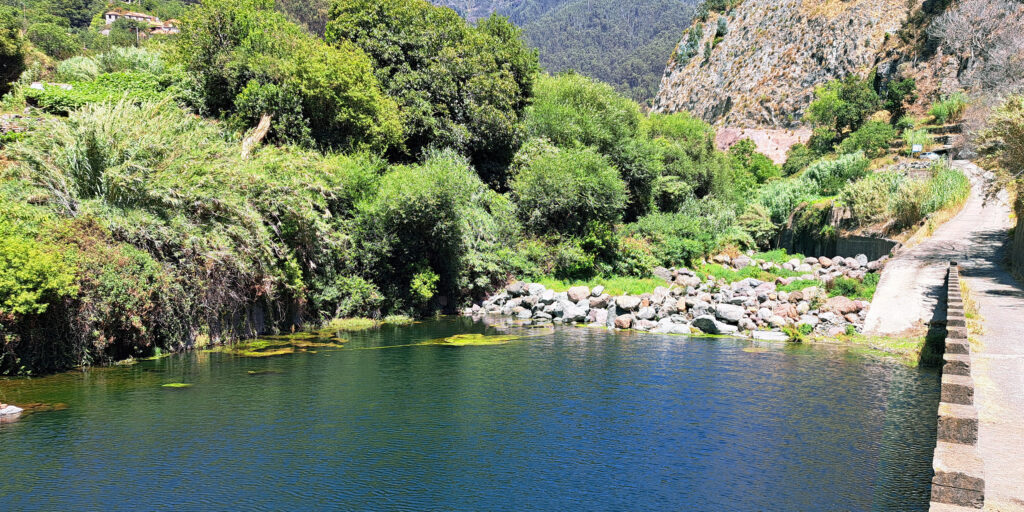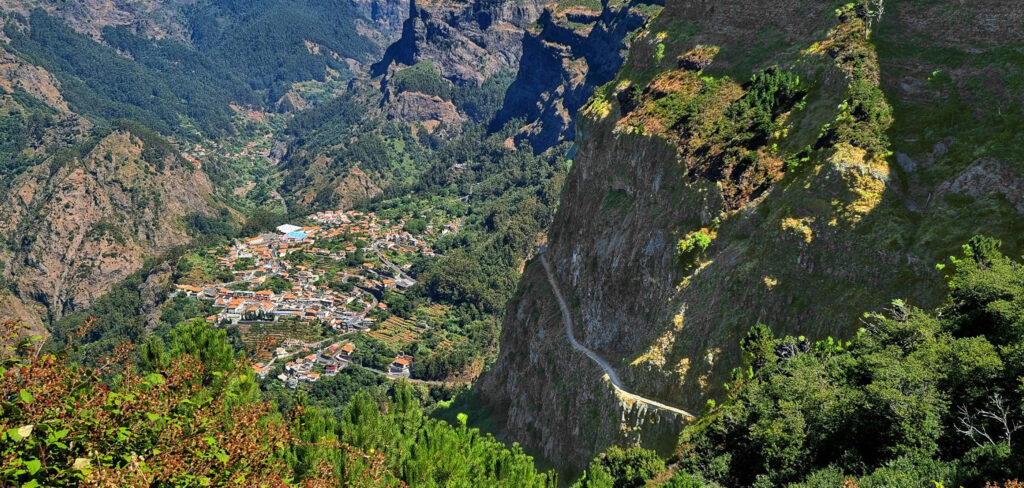
Curral das Freiras – All About Chestnuts!
Curral das Freiras (Nun’s Valley) is located in the heart of the island, nestled between towering mountains. Madeira’s highest peak, Pico Ruivo, lies approximately 3.2 km away in a straight line (!) to the northeast of the village.
The valley was formed over millions of years by volcanic activity and countless natural events such as water erosion, landslides, and rockfalls. And the process is still ongoing. The dynamic nature of the landscape is still evident today, as heavy rainfall frequently causes landslides that block access to parts of the village.
Nun’s Valley is one of the most picturesque places on Madeira and was originally called Curral da Serra. Due to its fertile soil and ideal sun exposure, lush pastures have long supported cattle and goats. Originally, the area was home to nomads and shepherds, and even runaway slaves who sought refuge here. They were the first to build small houses, and by the 15th century, permanent settlements had developed. More people followed, despite the region’s continued underdevelopment.
At the end of the 15th century, the land became the property of the nuns of the Santa Clara Convent in Funchal. It was changed to the name Curral das Freiras (“Nun’s Corral”). In the mid-16th century (1566), the nuns are said to have fled here from Funchal along a secret path to protect themselves and the monastery’s treasures from French pirates. Curral das Freiras is one of the few places on the island hidden between mountains and completely invisible from the sea.
The Journey to Curral das Freiras
Until relatively recently, reaching Nun’s Valley was a small adventure in itself! The village’s only original road was built in 1959, winding its way along steep mountain slopes with dramatic drop-offs.
Since June 2004, a tunnel has provided safe access to Curral das Freiras. The old road has since been closed to traffic, though it can still be walked at one’s own risk.

Due to its geographic isolation, the people of the valley have long relied on their own agricultural production, with a strong focus on horticulture. Today, chestnuts and cherries are the main sources of income. In the past, walnuts, lemons, oranges, cherries, cider, sour cherries, and some wine contributed to the Santa Clara Convent’s earnings.
The local sweet chestnuts are truly delicious and are widely used in traditional cuisine, such as soups, baked goods, and even liqueurs. Ginja is a local specialty – a liqueur made from either cherries or chestnuts, unique to this remote region.
Rare Birds
Surrounding Curral das Freiras, you’ll find stunning viewpoints that make the village look like a miniature model, including Eira do Serrado, Boca dos Namorados, Boca da Corrida, and Montado do Paredão.
Looking toward Pico Ruivo, you’ll realize how vital this habitat is for nature conservation. This mountain range is home to the endemic Pterodroma madeira, or Zino’s petrel, one of the world’s rarest seabirds. Thought to be extinct until the late 1960s, only 65–80 breeding pairs remain today. Their nesting area is restricted to the eastern mountain range, specifically small plateaus above 1,600 meters between Pico do Areeiro and Pico Ruivo. These birds likely got their name from their eerie calls, which shepherds in the Curral mountains thought resembled a choir of nuns.
Eira do Serrado
At 1,095 meters above sea level, Eira do Serrado is home to a namesake four-star hotel.
Starting at the hotel, a short 7–10-minute hike leads to the “Eagle’s Nest” (Ninho da Manta), offering a breathtaking view of Nun’s Valley and the Ribeira dos Socorridos valley stretching toward Câmara de Lobos. From this bird’s-eye perspective, you can clearly see how natural forces like rain shape and transform the landscape.
From Eira do Serrado, you can also hike down to Curral das Freiras via a historic, paved “oxen path.” This trail held great significance for the village, as it was one of the main access routes for centuries. It wasn’t until 1959, with the construction of the first road connection, that the path lost its importance.
The 6 km trail descends about 400 meters in elevation and takes approximately three hours. Along the way, you’ll pass through forested areas with eucalyptus, chestnut, and walnut trees.
The Poços – Natural Swimming Pools
On Madeira, the term Poço refers to a natural swimming pool, either created by volcanic activity (such as in Porto Moniz) or formed by dammed rivers (in the island’s interior). These pools are surrounded by large, smooth river stones, creating ideal natural bathing spots.
Curral das Freiras has two such Poços, perfect for bathing:
Poço dos Chefes
Located in the southern part of the village, this natural fluvial pool is fed by the Ribeira dos Socorridos. During low water levels, locals build a temporary dam to create a larger swimming pool, providing a refreshing escape amid the rugged mountain landscape.
Poço da Ponte (Poço do Fantelho)
Situated north of Curral das Freiras, this bathing spot offers another opportunity to enjoy the refreshing river waters. Its easy accessibility and family-friendly atmosphere make it particularly popular.
Levadas – Madeira’s Irrigation Channels
Some of the most notable levadas (irrigation channels) in this area include:
Levada do Piornais, which supplies water to São Martinho.
Levada do Curral and Castelejo, as well as Levada Nova de Câmara de Lobos, which irrigate much of the Câmara de Lobos municipality
The Levada da Velha was originally intended to transport water to Estreito, Quinta Grande, and Campanário, but it was never completed. Its name stems from a legend about a wealthy old woman (Velha) who supposedly initiated its construction. Remnants of this levada can still be seen on the western slopes of Curral das Freiras from the Eira do Serrado viewpoint.
Religious Sites
Church of Nossa Senhora do Livramento
Built in the early 19th century, this is the village’s only historical monument. It underwent major renovations in the early 20th century, including the addition of side altars.
Chapel of Santo Antonio
Built around 1644, this chapel no longer exists. It served as the parish’s main church when Curral das Freiras became an official parish in 1790, a function it retained until the early 19th century when the current church was built.
Festivals and Events
Every 1st of November, the Chestnut Festival attracts thousands of visitors to Curral das Freiras. Stalls offer all kinds of chestnut-based specialties, including chestnut cake, chestnut liqueur, chestnut soup, and chestnut bread.
A unique culinary event takes place every May: the Brigalhó Exhibition, hosted by Casa do Povo do Curral das Freiras. Brigalhó is the tuber of an endemic Macaronesian plant (Arum italicum ssp. canariensis). It grows in moist, shady areas of Madeira, the Azores, and the Canary Islands. Due to extreme food shortages in the past, this yam-like tuber became a survival food. However, it requires about 24 hours of cooking before it is safe to eat.
In late August, the village celebrates a major festival in honor of Nossa Senhora do Livramento, its patron saint.
Conclusion
Curral das Freiras, the secluded „Nun’s Valley“ in the heart of Madeira, captivates visitors with its dramatic mountain setting and rich history. Once a refuge for nuns fleeing pirates, the village has retained its authenticity. Today, it is known for its stunning viewpoints, traditional chestnut delicacies, and scenic hiking trails. Its deep connection to nature and tranquil atmosphere make Curral das Freiras a unique experience for travelers seeking the true essence of Madeira.
Curral das Freiras can be reached by bus from Funchal.
You get on the Horários do Funchal line 81 at the central bus stop next to the Almirante Reis car park and arrive in the centre of the village after an interesting journey.
Looking for more stress-free adventures on Madeira?
“Madeira by Bus” is your ultimate travel companion, featuring detailed bus schedules, insider tips, and must-visit destinations across the island. Whether you’re a first-time visitor or a seasoned explorer, this guide makes it easy to plan your journey.
👉 Get your copy today at www.madeira-by-bus.com/read and start exploring Madeira the eco-friendly way!


